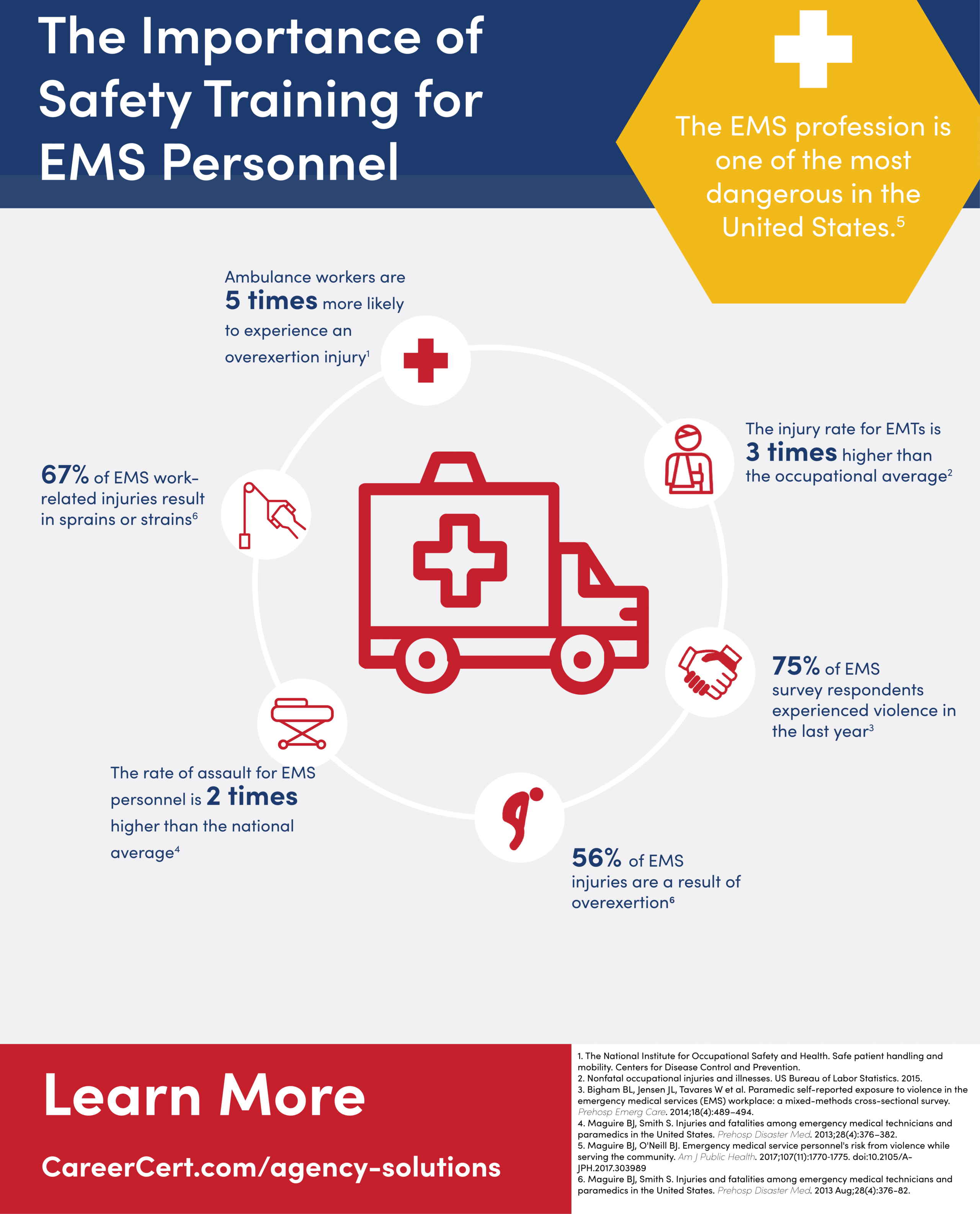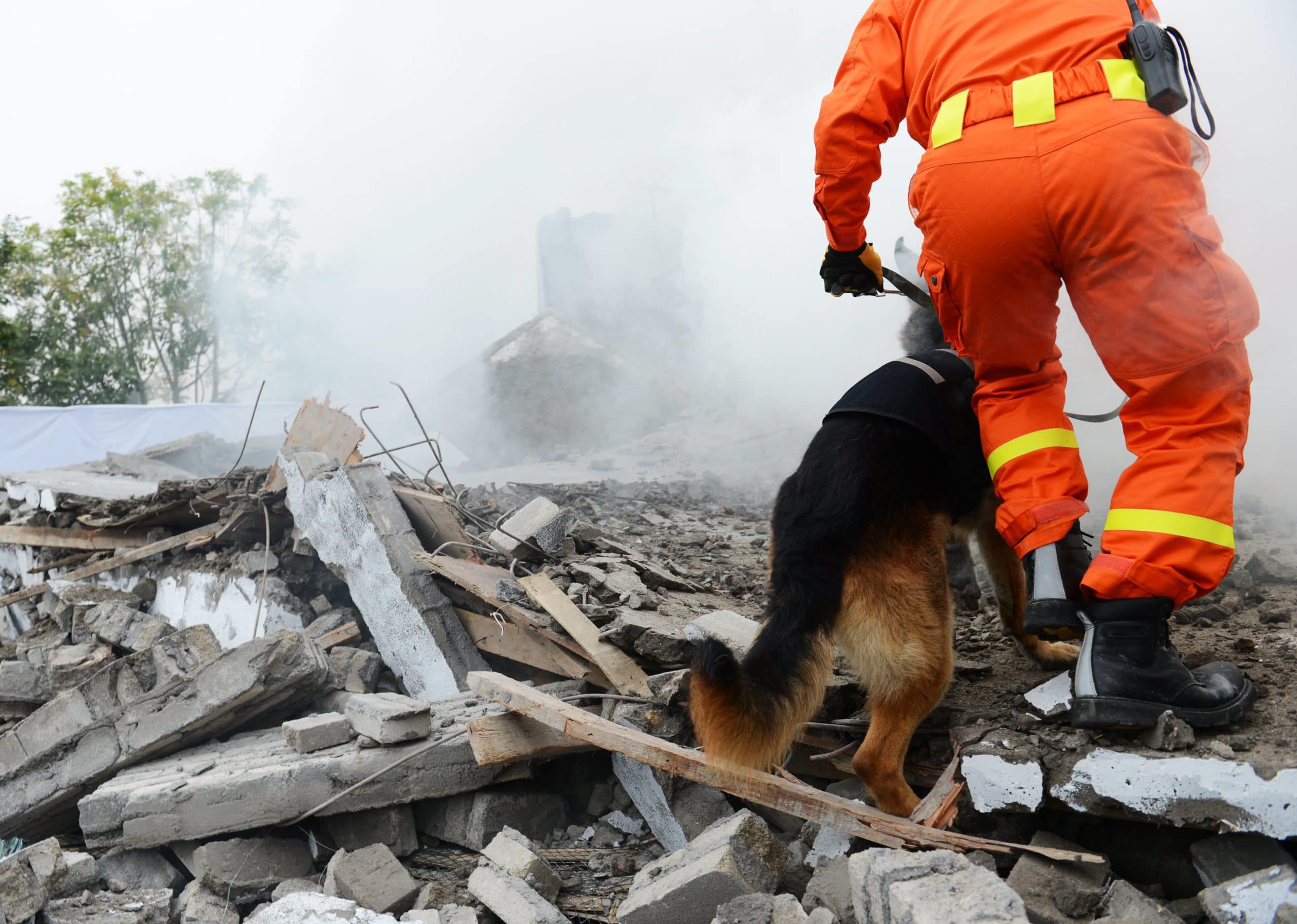When You Get Injured on the Job as an EMS Provider
One of the worst things we can hear as a responder is “man down.” It strikes fear into the heart of everyone listening and responding.
But what do we do when we are the one “down”?
Let us back up a bit to consider, how did we get into this predicament in the first place?
Creating a Safe Environment
EMS careers, by the statistics, have a larger chance of injury on the job than most other jobs. According to CDC NEISS-Work data files for 2017, EMS personnel accounted for 21,200 injuries alone.

We should be doing things to prevent injury to ourselves and others. Safety protocols, policies, reflective materials, being healthy, and situational awareness all play a part in prevention.
How do we remember all these preventative measures? Are we doing enough training and updating that training to stay ahead of the curve? What does your company or department do? Are you, as a provider, doing that little extra to keep yourself and your partner(s) safe? Safety must be an all-or-nothing proposition. If all the managers, leaders, and educators are on board with the best-proven practices to lead and educate their crews and workers, we should, and could, all be safer in the long run. As leaders, we must empower our personnel to suggest changes. (I know, I know; changes are so hard). Sometimes as leaders/supervisors/management, we lose sight of the day-to-day, minute things that we must be willing to hear and understand when our crews make suggestions. They are the ones who put into practice the policies, procedures, and rules when they go out on the road to perform their duties. Having them not only understand but think critically about these policies will increase the safety of our crews and our communities.
An eye-opening experience I had was when I attended a class on the Just Culture model, a class that first looked back to see what we have done in the past and re-tooled past practices into a more modern and much better practice. This model helps leaders differentiate between a system problem and a personnel problem and how to deal with each individually. It also teaches leaders that they themselves need to refocus on what the underlying problem is and prioritize quality education for their employees.
When Injuries Occur
 With that understanding in mind, and the unreliability of the universe, we can follow all these guidelines to a T and things still happen, people get injured, or worse.
With that understanding in mind, and the unreliability of the universe, we can follow all these guidelines to a T and things still happen, people get injured, or worse.
What do we do when we become that person? What happens and what can we do to minimize the extent of the damage to ourselves and others? And what do we do to start the healing, repair, and recovery?
A few years ago, I was injured on a CCT emergency response. I had a driver who had told the company several times that he did not like driving. He had had several “incidents” while driving. We were exiting the expressway, and, without warning, he slammed on the brakes. I had been doing a last-minute assessment of the patient, who was having a major MI, and went from the patient side to the bulkhead shoulder first.
By company policy, we are to be seat belted in place, unless performing life-saving measures or assessments.
I do not remember what my partner did after the accident. I was a bit dazed, but I remember the patient asking if I was okay. I also remember my partner attempting to decide whom to go to first. I told him to care for the patient. But it was several minutes before anyone came out to check on me. My partner was scared and confused.
If you ever find yourself in a similar situation, here are some practical tips.
- First and foremost, advise the communication center. This will help everyone receive the treatment and support they need as quickly as possible.
- Check on your partner. Size up quickly what happened.
- Check on your patient. Stay calm and keep them informed.
- Now, get help! Yes, we need to care for, attend to, and fix our partner. However, also understand that you may be worried and concerned for your partner, so your mind may not be in a proper mindset. Do what you can: triage, treat, and get help so you can provide the appropriate level of care!
If you are the one injured, get help! Get treated ASAP. Do not be a hero; do not shrug it off; don’t play it down! If you are hurt, you are now a patient. You are going to be cared for and treated as such. You NEED to get evaluated and treated. Too many times I have seen medics attempt to “walk-off” an injury only to have it come back and haunt them for the rest of their lives. Back, shoulder, elbow, wrist, and any other injuries need to be treated so you can come back to work healthy and pain-free. Believe me, it’s no fun working 35-plus years with chronic pains then retiring with those same pains.
Long-Term Recovery
After the initial treatment, now what? As you seek the appropriate care from healthcare professionals, follow the plan they outline for you! It might be physical therapy, it might be surgery, it might be rest and ice, but whatever it is, FOLLOW THE PLAN! Get a second opinion if that plan is not what you feel is best and gather as much information as you can about your treatment options, but get treatment.
Taking Care of Your Finances
There is a component of recovery that we, as people, do not like to talk about, and that’s finances. If you are injured, the money stops. You may have disability benefits (please, ask at hiring if they are available; it may save you later in your career!), but it is usually at a lower rate than your full pay. Start a rainy day savings account. Stash away part of your paycheck now so when the time comes you have something to get by for a while. Check and see if your company has worker’s compensation insurance; it may help with paying the big bills and recouping some lost pay or benefits.
Remember, bills still need to be paid while you are out of work, so plan ahead!
Depending on how your company or department is structured, you will more than likely need to talk to:
- First, your supervisor. They should be able to help you get the initial injury/accident/incident paperwork filled out and filed.
- Next, you should contact human resources, or your department’s equivalent, to get the rest of the paperwork/documents you need to start the process of recovery.
Keep records and copies of everything. Dates, times, names, numbers, anything that has to do with the incident, and your recovery needs to be documented with dates and times! Keep records, and keep them complete.
In my case, the recovery was long, painful, and, unfortunately, hindered at points along the way. Initially, it was physical therapy. Thirteen visits were all that was covered by worker’s compensation. During this time I also had several visits with an orthopedic surgeon and a nerve specialist. After surgery to fix the joint and 2 labral tears, I had more physical therapy. Unfortunately, after 2 years the final outcome resulted in a 45% loss of the use of my left arm. My overall compensation was based on a chart of loss of use, not the 15 or so years I could have worked if I was not injured, so I was glad to have a rainy day fund and other options to help with my financial recovery.
Find a Purpose and Good Goals to Focus on
Can’t sit still? Got a case of the fidgets because you are “out of work”? See if your employer has a light-duty option. It may not be an option, based on the injury, but if you are capable AND your doctor/therapist/treating person says you can do some work, ask your employer for options. It gets you off disability, out of the house, and keeps you involved. Maybe learn a new skill or get a better idea of how things work at work.
While it can be frustrating to have physical limits, set new goals for yourself that will help you continue to grow. Whether you take continuing education courses that could help advance your career, start a new hobby, or start a work project at home, have a set of tangible goals that will keep you motivated and growing.
Take Care of Your Mental Health
Now that you’ve followed the treatment plan and paid the bills, you have recovered nicely from your incident. Or have you? Are you physically and mentally ready to go back to work? Is there anything still bothering you about your incident? Talk to someone. Find a therapist, coworker, friend, or supervisor and talk about your readiness. If you are comfortable, ready, and cleared to go back, remember: you still have a choice. Make sure that you are absolutely mentally and physically ready to go!
Aside from the physical pain and frustration I felt after this incident, there was a mental side to it as well. I became frustrated with not being able to do what I had loved doing for the past 35 years. I had no contact with my work friends for months, and when I did go back, it was in a changed role. I was moved to a communications center supervisor position from my road crew chief position. I was working, but I was not involved with the road crews, the patients, the hospital staff, and the fire and police departments out where the action was at. It was depressing.
But I hoped that with physical therapy I would be able to someday soon go back to the streets I loved. As treatment progressed, I began to realize that I would not be going back on the road, permanently. I did go back out for a few months, but it became very apparent that I could not perform as I had and that the damage was too great to overcome. I had to start to deal with the fact that I, a seasoned critical care medic and former firefighter, was no longer able to perform at an acceptable level. I had to move on.
There are several avenues to deal with the stress, failure, and delay of recovery. Employee assistance programs, your human resources department, doctors, and therapists are all good places to start and continue seeking help in dealing with the downside of recovery. Also, never forget the importance of friends, family, and co-workers in your recovery. Just be ready, and willing, to learn that things can change after an incident.
In conclusion, injuries happen, so be prepared physically, mentally, and financially, well before something happens. Find out beforehand whom to contact and what steps may need to be taken to start on the road to recovery. Expect roadblocks and plot twists along the way. Most of all, take care of yourself.
 Marc L. Cohen—NRP, CCEMT-P, FFII, HAZMAT Tech, WoW Dwarf Paladin—has over 38 years of experience in the EMS industry and 9 years of experience in the fire service. Marc served as a critical care paramedic, a supervisor, and an American Heart Association instructor before joining CareerCert. His passion for the industry, knowledge, and expertise make him engaging and entertaining as an educator. His responsibilities have spanned all areas of the field.
Marc L. Cohen—NRP, CCEMT-P, FFII, HAZMAT Tech, WoW Dwarf Paladin—has over 38 years of experience in the EMS industry and 9 years of experience in the fire service. Marc served as a critical care paramedic, a supervisor, and an American Heart Association instructor before joining CareerCert. His passion for the industry, knowledge, and expertise make him engaging and entertaining as an educator. His responsibilities have spanned all areas of the field.


